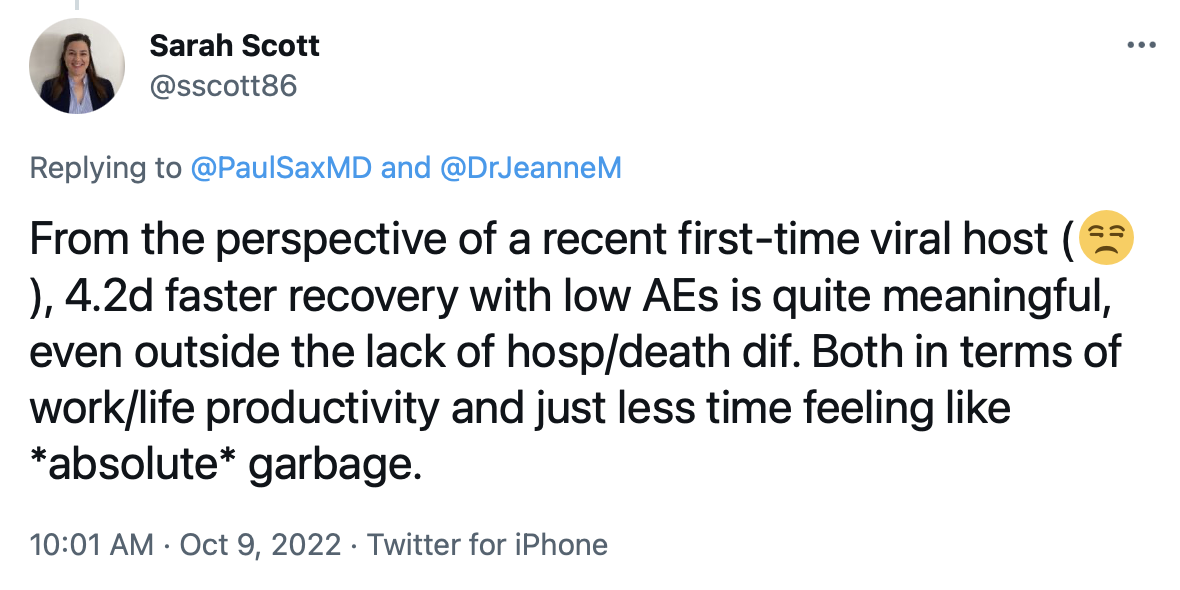An ongoing dialogue on HIV/AIDS, infectious diseases,
October 10th, 2022
Molnupiravir Results in PANORAMIC Study — It’s Not All Bad News
Last week, the large PANORAMIC trial of COVID-19 treatment in outpatients with mild-moderate disease appeared in a pre-print. This large (25,783 participants!) randomized, open-label study compared molnupiravir vs. usual care in adults 50 or older, or having comorbidities known to make severe disease more likely.
The results?
Molnupiravir vs standard of care for outpts with Covid19. No difference in the already low rate of hosp/death, but take a look at this Time to Recovery 2ndary endpoint, a 4-day benefit! Robust across subgroups. Caveat: Open label design. https://t.co/t07aqg68s9 h/t @ASPphysician pic.twitter.com/MExXZLOTp2
— Paul Sax (@PaulSaxMD) October 6, 2022
Four days faster recovery with treatment! You might think this would be welcome news.
Ah, but think again. Because the response from the ID cognoscenti was lukewarm, and that’s putting it kindly.
Many cited the study’s open-label design as a major limitation, negating the favorable time-to-recovery result. The placebo effect is certainly in play when a person knows they are receiving active treatment.
Some noted the ongoing concerns with molnupiravir and mutagenicity — and the theoretical worries about generating variants.
Others criticized the cost of the drug.
But the major theme of the naysayers emphasized the inability of the treatment to demonstrate a benefit in the primary endpoint of interest — hospitalization or death. Here the result was quite low for both arms, and equal, at 0.8%. Not a bit of difference, and this lack of efficacy is also what the headlines typically featured.
As a result, when I polled people on whether they would prescribe molnupiravir now that they know the results, it didn’t surprise me that a majority said no.
Molnupiravir vs usual care in large open-label randomized trial. Pts mostly vaccinated; omicron era:
– Primary endpoint: no difference in hosp/death (0.8% for both)
– 4.2 days faster reported recovery
– faster viral clearance
– serious AEs 0.4% for both
Would you prescribe it?— Paul Sax (@PaulSaxMD) October 8, 2022
With the caveats that this sort of poll is only representative of the people who saw and answered it, and that Twitter can be a really negative place — like “staying too late at a bad party full of people who hate you” — I do think it’s worth acknowledging these important concerns about both the study and the drug.
But it’s also worth highlighting the good news coming out of this trial — and it’s very good news indeed.
First and foremost, the amazingly low incidence of hospitalization or death underscores how much less severe COVID is now compared to when it first hit the human race. It’s especially notable since the study population included only those at risk for bad outcomes. When it comes to most infections, it’s a wonderful thing not to be immunologically naive, and the participants had very  high rates of vaccination and/or prior infection.
high rates of vaccination and/or prior infection.
(Parenthetically, the lower disease severity presents a virtually insurmountable challenge to conducting a clinical trial with this “hospitalization or death” endpoint — as noted by Dr. David Boulware, the sample size would need to be extraordinarily large.)
Second, let’s go back to the observed faster time to recovery for a moment. A 4.2-day improvement in time to recovery with no major short-term side effects — or drug interactions — is nothing to sneeze at, if you’ll forgive the very apt cliche. As a point of reference, this is quite a bit more than the observed clinical benefit seen with oseltamivir and baloxavir for influenza, which is typically 1-2 days. Note also that there is no mention of clinical or virologic rebounds, though perhaps the researchers did not assess for these endpoints.
So let’s imagine you are a person with COVID. You’re miserable — feverish, sneezing, coughing, out of work. Not hospitalization-level sick, but feeling pretty lousy.
Your doctor tells you they have a 5-day treatment that, in a large study, shortened the time to recovery by 4-5 days compared to people who didn’t get the treatment.
Plus, there were no major side effects, and the amount of virus dropped faster, too.
Wouldn’t you at least consider it?
Or, as Dr. Sarah Scott writes:

Well said. While acknowledging that the open-label design makes ascribing this benefit solely to the drug is impossible — people really want to believe that their treatment is making them better — we can also note that this difference in time to recovery is substantial, even by the standards of other non-placebo controlled trials.
Finally, the PANORAMIC investigators deserve a ton of credit carrying off this very large, pragmatic clinical trial. We all look forward to seeing it go through peer review and revision, information about rebounds (if they happened), as well as the promised follow-up data regarding long COVID. Also, the results of the nirmatrelvir/r (Paxlovid) arm of the study promise to be particularly interesting, as this is way more widely used than molnupiravir for COVID treatment, at least here in the United States.
Meanwhile, enjoy this video, because I certainly did.


Budesonide can already speed up clinical recovery by three days, without the risk of birth defects and mutations in the SARS-CoV-2 spike protein, which might lead to the emergence of new variants. Plus budesonide only costs $15 per course, versus US $700 for molnupiravir? This benefit for budesonine was demonstrated by the same study team at Oxford University in another large randomised trial called PRINCIPLE. So what is the role for molnupiravir?
https://www.thelancet.com/article/S0140-6736(21)01744-X/fulltext
Interesting point. However, with the budesonide arm of the PRINCIPLE trial having been performed much earlier in the pandemic with dominant strains that had much higher affinity for the lower respiratory tract than BA.1 and subsequent variants, I don’t think it’s possible to extrapolate the finding of shorter duration of illness with budesonide to current strains.
As much as I’m not a fan of the mechanism of action of molnupiravir, if subsequent data shows a lack of rebound infection, I would choose it over Paxlovid. I’m seeing roughly 10% of my patients rebound with Paxlovid, far more than the 2% (or less) reported in the literature.
Andrew,
Very reasonable point about budesonide, and agree that molnupiravir has potential risks. But another view that an inhaled anti-inflammatory drug works by a very different mechanism of action than an antiviral, with the latter having more systemic effects, possibly reducing risk of transmission (could be studied), and eventually decreasing long covid (it’s plausible). One other thing that’s unclear in the manuscript is whether the time to recovery benefit is 4.2 days or 6 days (15 minus 9). Both are quite big, even for an open label study!
-Paul
When you are comparing to Pax, why are you focused on the rebound? Have any of these patients had more than typical cold symptoms the second round? There is really no evidence people with rebound are a significant risk to spread the virus, so the key might just be to not test again and let it go.
Before starting, I want to say how much I have enjoyed learning from Dr. Sax’s insights and the highly informative exchanges. Most helpful.
A key question that I have and that relates to this previous discussion regards what the nature of the true problem is with patients that seem to have trouble eradicating the coronavirus. If patients still have evidence of virus persisting in their secretions, it would seem that treatment with drugs that have anti-viral properties rather than corticosteroids (which suppress immunity) would be the right way to go. Alternatively, treatment with drugs that boost host immunity, for example IFN-gamma, might be indicated – see Interferon gamma immunotherapy in five critically-ill COVID-19 patients with impaired cellular immunity: a case series – Med vol. 2 Issue 10, 8 October, 2021, 1163-1170; van Laarhoven et al. In this study, the investigator
s showed that SARS-CoV2 viral load decreased with initiation of interferon gamma therapy.
A second key question that I have relates to exactly how indicative of persistent viral infection is the routine rt PCR for SARS-CoV2? Some investigators have argued that the rt PCR test will detect inactive pieces of the virus that remain after the actual live virus is eliminated from the body. I cannot get a good answer from my microbiology colleagues on this key question regarding the accuracy of the rt PCR test for indicating live virus versus inactive viral particles. It would seem as if the field would benefit enormously from a more accurate assessment of true viral load.
Thank you very much for keeping us informed about this and many other ID issues. In your summary, you mention that there are “ongoing concerns with molnupiravir and mutagenicity — and the theoretical worries about generating variants.” And I think those concerns are very worthwhile because the mechanism of action of molnupiravir precisely involves the induction of RNA mutations in the viral genome. So the fear here is that widespread use molnupiravir might actually accelerate the emergence of SARS-CoV-2 mutants/variants, some of which might be of clinical concern.
But it should also be noted that molnupiravir and its active metabolite N-hydroxycytidine can also induce DNA mutations. And the concern here is that molnupiravir could also damage patients’ genomes and therefore increase their cancer risk.